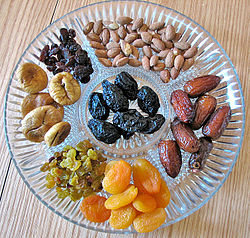Dried fruit
Dried fruit is fruit from which the majority of the original water content has been removed either naturally, through sun drying, or through the use of specialized dryers or dehydrators. Dried fruit has a long tradition of use dating back to the fourth millennium BC in Mesopotamia, and is prized because of its sweet taste, nutritive value, and long shelf life. Today, dried fruit consumption is widespread. Nearly half of the dried fruits sold are raisins, followed by dates, prunes (dried plums), figs, apricots, peaches, apples and pears.[1] These are referred to as "conventional" or "traditional" dried fruits: fruits that have been dried in the sun or in heated wind tunnel dryers. Many fruits such as cranberries, blueberries, cherries, strawberries and mangoes are infused with a sweetener (e.g. sucrose syrup) prior to drying. Some products sold as dried fruit, like papaya and pineapples are actually candied fruit. Dried fruits retain most of the nutritional value of fresh fruits. The specific nutrient content of the different dried fruits reflect their fresh counterpart and the processing method. In general, all dried fruits provide essential nutrients and an array of health protective bioactive ingredients, making them valuable tools to both increase diet quality and help reduce the risk of chronic disease. Today, dried fruit is produced in most regions of the world, and consumption occurs in all cultures and demographic segments. In the United States, Americans consumed an average of 2.18 lb (1 kg) (processed weight) of dried fruit in 2006. Raisins accounted for about two thirds of this.[8] California produces the largest percentage of the US and the world's dried fruit crop. It accounts for over 99% of the US crop of raisins and dried plums, 98% of dried figs, 96% of dried peaches, 92% of apricots and over 90% of dates. Most of California dried fruit production is centered in the San Joaquin Val

ey where the soil and climate, especially the hot, dry summers, provide ideal growing conditions. While these fruits were commonly dried in the sun in the past, now only raisins are almost entirely naturally sun-dried.[9] Fruits can be dried whole (e.g. grapes, berries, apricot, plum), in halves, or as slices, (e.g. mango, papaya, kiwi). Alternatively they can be chopped after drying (e.g. dates), made into pastes, or concentrated juices. The residual moisture content can vary from small (3 – 8%) to substantial (16 – 18%), depending on the type of fruit. Fruits can also be dried in puree form, as leather,[10] or as a powder, by spray of drum drying. They can be freeze dried: fresh fruit is frozen and placed in a drying chamber under vacuum. Heat is applied and water evaporates from the fruit while still frozen".[11] The fruit becomes very light and crispy and retains much of its original flavor. Dried fruit is widely used by the confectionery, baking, and sweets industries. Food manufacturing plants use dried fruits in various sauces, soups, marinades, garnishes, puddings, and food for infants and children. As ingredients in prepared food, dried fruit juices, purees and pastes impart sensory and functional characteristics to recipes: Dried apricot paste from Syria The high fiber content provides water absorbing and water binding capabilities, tenderization and nutritional enhancement. Organic acids such as sorbitol act as humectants, provide dough and batter stability, and control of water activity. Fruit sugars add sweetness, humectancy, surface browning and control water activity. Fruit acids, such as malic acid and tartaric acid, contribute to flavor enhancement and act as anti-microbial agents (suppress mold and bacterial growth). Vitamins and minerals increase nutritional value and label appeal. Phenolic compounds slow down lipid oxidation in meats. They add a natural caramel color.